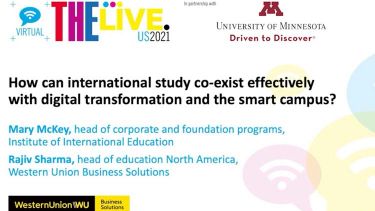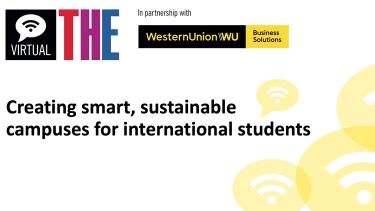
Source:
Western Union

A Times Higher Education and Western Union Business Solutions roundtable discussed best practice for sustainable development, pastoral care and digital learning
Universities face a dilemma when it comes to supporting their environment. They are keen to attract a diverse student body from around the world and to form international partnerships, yet earlier this year, a study found that the carbon footprint of global student mobility equates to the annual emissions for the whole of Tunisia. As part of the Times Higher Education 2019 World Academic Summit, leaders from international universities came together at a roundtable event to discuss their roles as agents of change regarding not just environmental issues but also student well-being and the impact of technology on students’ lives.
Co-chaired by THE deputy features editor Jack Grove and Skyler Webster, director of product management at Western Union Business Solutions (WUBS), the roundtable discussion reflected on WUBS’ The Future of Studying Abroad report, which analyses trends in student mobility. It found that, while the number of students travelling to the US and the UK is in decline, Russia and China are increasingly popular destinations. More than a quarter of international students choose not to stay in the country where they study, and return home to work. “They’re looking at what universities do around not just sustainability, but also their stance on political and social issues, and how they serve students digitally,” noted Webster, highlighting that there are a number of factors that influence this decision.
WUBS has identified five types of students: eco-influencers, who will dislike paper pamphlets and wasted resources; empathists, whose key driver is purpose and who make decisions based on their core values; resilience warriors, who seek out student well-being services and mental health support; digi-learners, who are interested in studying online; and radical flexers, for whom the lines blur between studying, resting and socialising – mirroring a similar trend in the modern workplace. How universities respond to the needs of these student tribes is increasingly important, said Webster.
Universities becoming the agents of change that students want to see can come at a price, however. Monash University in Melbourne, Australia, has international campuses in Malaysia, China, India and Italy. Susan Elliot, its deputy vice-chancellor for education, said that the institution’s commitment to becoming net zero (in terms of emissions) across its Australian campuses is “costing us millions of dollars”. The university has invested in solar panels and carbon capture technology so that it can monitor its environmental usage, and is moving to renewable sources of energy. It is also working with its own environmental scientists to look at how it can offset travel. “We recognise that we’re a university across four campuses and, as humans, we’re social animals and we still want to see each other in person,” said Elliot. Buy-in from students is a happy by-product rather than a motivator, she added: “We want to show how a large, complex institution can become net zero. We want our current students to know that we are genuine as a leadership, wanting to make change for their generation and subsequent generations.”
With growing international student populations, universities must also be able to offer a compelling pastoral support system for young people who may be outside their home country for the first time. Karma El Hassan, professor director of institutional research and assessment at the American University of Beirut in Lebanon, talked about some of the opportunities offered by her institution to students from sub-Saharan Africa. “They are good students, but they have never been out of their villages, so we need to coach them and orient them to a new culture,” she explained. The American University of Beirut also offers scholarships to women from Afghanistan, and has a dedicated unit to guide international students with services such as language learning and mentoring. Vladimir Filippov, rector of RUDN University in Russia, said that finding the best international students and preparing them for life at university was more important than expecting them to come to you. “We have more than 100 nationalities on campus and use our associations with those countries to help us find those gifted students around the globe. We need to give them the right conditions to leave [their home country],” he said. Student associations and social media groups can form an important part of such a provision.
One topic that attracted great consensus was the pivotal role that technology plays in the lives of students. Susan Elliot talked about the dichotomy between significantly more students suffering from online addiction and the benefits that technology can add to students’ learning and social experiences. “Some students feel a terribly addictive power from being online in the same way they might with substance abuse,” she said. “Yet many students decide to take a ‘virtual’ seat in lectures – you’ll see them watching them on the grass at the same time they’d be sitting in the hall. They can ask a question remotely via the technology. And it’s not just those 8am or 6pm classes – it’s any time of day.” Anna Derevnina, associate provost and dean of education at Skolkovo Institute of Science and Technology, made the point that “digital natives” are the same whatever their nationality. “We use learning commons so students can come together and view subscriptions and e-books as a community,” she said. “We need to explain some things around cultural behaviours and offer them language learning opportunities, but when it comes to technology they’re absolutely the same.”
Digital platforms are also at the centre of the “customer experience” for students, argued Vinitha Gengatharan, executive director of York International at York University in Canada. She said: “They want a seamless user experience. We found that 83 per cent look at a website to choose an institution rather than physically go there. They look at how easy it is to get information, the ease of the registration process, whether they can pay the university directly rather than have to go to a bank.” And while it’s easy to assume that all students are glued to their smartphones, even how they interact with this technology has subtle differences between international populations – something universities must bear in mind, noted Dino Leo, head of education, Europe, at WUBS. “You go to China and in the payment line they’ll all be focused on their phones, but US students chat with each other,” he said. “When you’re receiving students from 150 countries, that’s 150 mobile and payment cultures you need to interpret.”
Western Union Business Solutions is supporting universities globally to provide financial infrastructure so that they can readily welcome academics and students from overseas with ease.
Find out more about Western Union Business Solutions for education.




